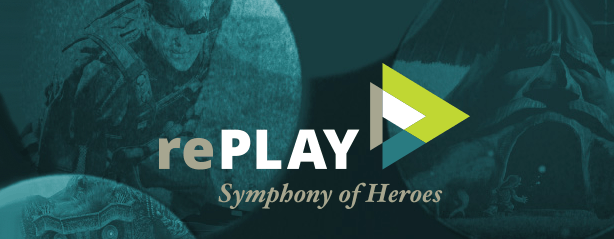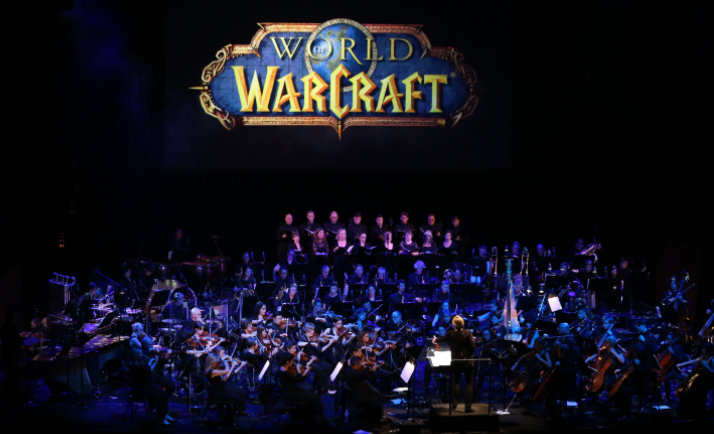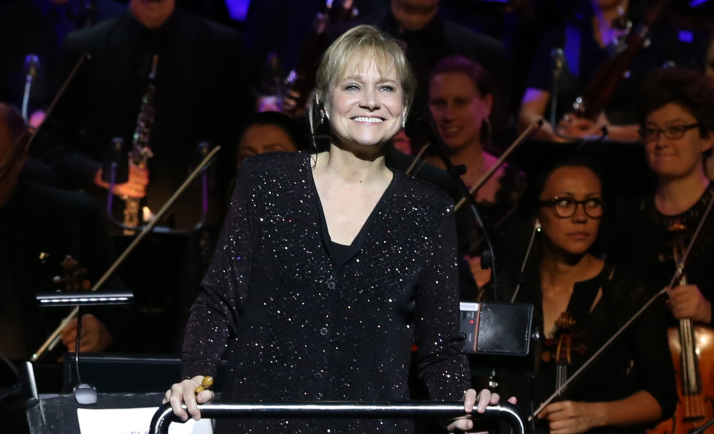rePLAY -Symphony of Heroes-: Houston, July 2014
The rePLAY: Symphony of Heroes tour premiered earlier this year with concerts in Sydney, Australia and Florida. I was finally able to see it in Houston this past weekend on July 5, performed by the Houston Symphony Chorus and led by conductor Miriam Burns. Produced by Jason Michael Paul, rePLAY is something of a sequel-concert to PLAY! A Video Game Symphony, but with a new series of pieces from different games. The program consists of sixteen full pieces, each one followed by a narration. The symphony uses a story of its own, incorporating Joseph Campbell’s monomyth so that each piece represents a stage of the hero’s journey, from “The Call to Adventure” (represented with the main theme of Jeremy Soule’s Oblivion) all the way to “Master of Two Worlds” (represented with a Suite from Halo). The narration had a tendency to take you away from the musicality of the symphony and adding longer pauses between pieces, but I enjoyed the way it created continuity and a storyline between the pieces. The pieces themselves were accompanied by video footage from the corresponding game.
Opening the concert, the Main Theme from Oblivion was a snippet rather than a full-fledged piece; it got the audience’s attention and died down as Burns turned to speak with the audience, explaining how the narration would work in the concert. She also gave some games that would be featured in the concert, each one followed by a cheer from various sections of the audience as listeners caught the names of games they had come to hear. As an avid symphony-goer, I have to say that the game music audience is one of the greatest; they have a wild enthusiasm that is just not heard of in most symphony halls. Eimear Noone, the conductor of the The Legend of Zelda: Symphony of the Goddesses, told me once that she loves the passion that her audiences come with, cheering wildly after each piece. It may not be conventional, but I have to think that Burns feels something similar getting a massive roar of approval from the audience after listing “Portal” or “Kingdom Hearts” or “Halo.”
Oblivion was followed by the main theme of Austin Wintory’s Journey, which I saw as the real opener. It was the first full-length piece, and I was pleasantly surprised that rePLAY opened this way. I saw “Liberi Fatali” from Final Fantasy VIII much later down on the program, and while it did seem like an obvious opener piece, it did not fit with the Campbell narration cycle, which began with Call to Adventure and Refusal of the Call. When it comes to the nature of a hero’s journey, what is more self-referential than Journey? In any case, it was a thoughtful, gentle, and exquisite opening, and when combined with the calming images of Journey, the music put the listener in a tranquil state. The next piece, “Suicide Mission” from Mass Effect 2, brought the listener out of that state without being too startling; the piece began slowly with gently rolling strings, not unlike Journey. As it continues, however, a syncopated rhythm develops that very slowly develops over the course of a couple of minutes and by the end takes over the piece. The accompanying images become increasingly dramatic along with the piece, including both gameplay and cutscenes from some great fight scenes, making great use of any scene involving the biokinetic abilities from the game.
Guild Wars 2‘s featured piece was “Supernatural Aid”, a combination of a few of the themes from Guild Wars. It proved a delightfully animated score, sounding like a crossover between Oblivion and any one of the Fable titles: simultaneously dramatic and light, animated and solemn. This was followed by one of my favorites from the night, Suite from BioShock. I am not too familiar with Gary Schyman’s work on the series, but whether it was the particular selection of clips projected on the screen, the specific tracks chosen, or the arrangements, it was really a fantastic combination. For the first time in the concert, the video wasn’t just there to add drama; the clips were sweet, creepy, and underwater. If those aren’t adjectives you usually see together, then I have chosen the right ones; BioShock is a game very unlike other games in its time, and hard to pin down — it’s Ayn Rand philosophy mixed with first person shooter. Much of the music in the game is unoriginal, taken from 1930s, 40s, or 50s pop music; the suite used at the symphony was all original Schyman, for which I was grateful. It ended up being a wonderfully twisted suite with some fantastic visuals. If I could go back and relisten to one piece from the concert, it would be this one.
Lair was the next soundtrack, featuring only the “Main Theme” of the game. This was, for me, one of the weakest moments of the concert. The game was unfamiliar to several people in the audience (myself included) and, while John Debney’s score for the game was well-received, this particular track did not stand out as being much more than yet another dramatic theme in a series of themes, ultimately fading into obscurity among the other great tracks. We did hear a solo vocalist in this piece for the first time; she returned later on in the concert to sing in a few other pieces. For this piece, she sang in a Gaelic language, but her voice didn’t come across as strongly as it might have, and the result was simply another piece of the concert.
God of War: Ascension and Dragon Age: Origins made up for Lair, however; both scores are powerful, and not just because they go with games about dragons and war among the Greek gods. Tyler Bates’ music for the former maintained a pounding rhythm essentially throughout the entire soundtrack, never letting up during Kratos’ quest for redemption. The piece is preceded by the appropriate narration, The Road of Trials. The main theme presented here contained the usual pulsing rhythm with a rapid brass melody, very ominous in nature. The raw power of this track worked nicely between Lair and Dragon Age; the God of War series’ soundtrack as a whole can be overwhelming because of its constant energy, but between two dramatic, soulful themes for two dragon games, it served as a nice buffer and a fun break. Dragon Age: Origins then lent a more subdued voice to the concert; the vocalist from Lair returned, but this time through an often-wordless solo in “I Am The One,” the acclaimed main theme for the game. The soloist seemed to have gained more confidence or comfort with the concert by this track, and her voice stood out much more clearly, resonating with better tuning and timing. Inon Zur’s compositional abilities shine through in this piece, and the arrangement worked well with the orchestra, sounding much fuller than in the original score. I could even pick out a well-synthesized harpsichord among the instruments.
The first half ended on a humorous note with Variations on one of the themes from Portal 2. The narration before this piece concluded with an unusually comedic punchline regarding getting distracted when presented with a cake, the audience laughed and cheered simultaneously, and the orchestra began to play “Cara Mia Addio” with the projector showing clips from Portal 2, including dancing turrets, cubes and Atlas and P-Body from the game’s original trailers. The music consisted of a mix of songs from the Songs to Test By soundtrack, including snippets of “Halls of Science 4”, “Turret Wife Serenade”, and “Machiavellian Bach” (during which the synthesized harpsichord returned). It was a hilariously fantastic conclusion to the first half, and I was happy to see most of the listeners laughing just as hard, if not harder, as I was.
The second half began with a great theme from Metal Gear Solid, using clips from MGS IV, serving as a great opening. The theme is a fun one, fast-paced, triumphant, climatic, hair-raising, and the arrangement worked well. Harry Gregson-Williams doesn’t often compose for games, being primarily a film score composer, but his contribution is chalk-full of talent and ability, and fit very well for a string orchestra. The performance also featured an acoustic guitar soloist, who contributed with some fantastic solos (as he also returned in later pieces). The guitar was a nice touch to the symphony, adding variety to the pieces and new variations on old arrangements. For Solid Snake fans, this arrangement served as a great tribute to what has been a highly successful series.
Metal Gear was followed by two iconic tracks from Chrono and Final Fantasy.I was surprised that neither of these pieces had videos to go with them, particularly since the opening of VIII is so classic; I assume this had to do with Square Enix’s rights, but the later Medley from Kingdom Hearts did have accompanying video. In any case, the arrangements to both were wonderful nods to those loyal fans of Square. The piece from Chrono was a suite consisting of several themes, starting, of course, with “Scars of Time”. As much as it is over-covered, I was blown away by how fantastic that piece sounds with a live orchestra. It was, for lack of a better word, awesome. The only thing that bothered me about this arrangement was that the concertmaster of the orchestra didn’t have a mic; during extraordinarily high violin solos, when the rest of the orchestra is pounding away with the rhythm, I realized I was relying on my knowledge of the piece and chord progressions to know what came next, but actually hearing her was difficult.
“Liberi Fatali”, the iconic track from Final Fantasy VIII had a similar issue. During the opening of the game, the alto singers get much of the melody, but they were being drowned out in the arrangement by the soprano singers. I had heard this song live in recordings and noticed a similar problem, but this was the first time I heard it in a concert setting, and did not realize that it was more than just a recording issue. I think this is one of the problems with studio-recorded instruments being translated to live arrangements; control over dynamics is much more difficult and requires more precision, and often rewrites or special adjustments are necessary to produce the same sound (with the better quality). These issues aside, however, I was very happy to be able to hear such iconic tracks from my childhood, and I got the appropriate level of excitement being able to hear them live for the first time (especially “Liberi Fatali” — I mean, who doesn’t love that opener?).
A suite from World of Warcraft came next, which I really enjoyed. I am not the biggest fan of the the game’s soundtrack, finding it generally bland, but the tracks chosen for this sequence worked out beautifully. The solo vocalist returned for the final time in this piece, and here I found that I loved her voice. This was the piece I thought she nailed – for the first time, her voice shone above the rest of the choir, it was on-point, and it didn’t just seem like she got her notes correctly — instead, she owned the piece. The suite itself was pretty good, taking more of a form than the average WoW track, and successfully incorporated the entire orchestra, but it was the soloist who made this particular piece. Whether it was because she was finally feeling confident or because it was in a style that she felt most comfortable singing, I would have loved to get a recording of this performance just because of the ability she demonstrated.
Castlevania and Shadow of the Colossus both involved decent arrangements, although neither were highlights of the performance. Both pieces used the main themes of their respective games. Castlevania began by showing clips from the earliest platform games in the series, and then moved on to scenes from Lords of Shadow 2, which comprised the majority of the Suite. Shadow of the Colossus featured the Main Theme; the audience cheered upon first hearing that little recurring violin chime at the beginning. Shadow of the Colossus has a wonderful soundtrack; I think my issue with this arrangement was that it simply didn’t add much. That being said, I’m not sure how much could have been added, as the original game is very well orchestrated. Hearing it live was certainly a treat. However, I often enjoy hearing the differences — articulations, variations, transformations — between the original soundtrack and the live orchestra. For those who want to hear Ko Otani’s soundtrack live, it works well. For those who want an arrangement, this isn’t the place to look for one and A Night in Fantasia 2009 is a better fit.
A medley from Kingdom Hearts served as the penultimate piece of this program. The medley mainly consisted of “Hikari” and “Passion” the two main games. I think the audience cheered more loudly at the beginning of this piece than any other; I would guess many of them had shown up most looking forward to seeing this piece. The video was fun, consisting mostly of clips from the various openers of the games, including both the home and portable console titles. The piece made me feel nostalgic, as well as in want of a Kingdom Hearts video game symphony (hey, if we’ve got one for Zelda and one for Final Fantasy, why not Kingdom Hearts?); I found myself wanting to hear some of the specific themes from different worlds within the games. The performance was good, though, and for a video game symphony that covers so many different games from varying genres and countries, I expected nothing less than these iconic opening and closing songs.
A friend I went to the symphony with pointed out that the two halves of the symphony seemed to be divided into Eastern and Western games (with the exception of World of Warcraft in the middle of the second half). This pattern made sense, but was then broken with the conclusion of rePLAY with a Suite from Halo. I happened to be sitting behind some guys in their early twenties who leapt out of their seats and roared at the first few notes. I am often hesitant when judging scores to first-person shooter games, as I generally have unfairly low expectations; Martin O’Donnell’s and Michael Salvatori’s score to Halo is one of the exceptions to this. I love the soundtrack to Halo, and I love how O’Donnell arranged the score into a series of suites to make for better listening. I always appreciate when composers take the time to adjust their music for both in-game and ex-game listening, although it happens rarely. The result is a series of great suites, one of which was played to conclude rePLAY, that is both iconic and enjoyable, whether or not the listener is familiar with the franchise.
That should be said for the whole symphony — it was the kind of performance that was enjoyable even to those unfamiliar with the games. The music was fun, catchy, and dramatic, and the accompanying images made effective trailers to the games represented in the music. At the end, Burns acknowledged each soloist and section in the orchestra while a recording Skyrim’s Dragonborn played. My program was full of notes by the end of the symphony of scores and games I wanted to look up afterwards — after all, I am nearly always drawn to play a game by its soundtrack. I was very happy to get the opportunity to attend my first PLAY symphony, and I will be looking forward to the next sequel symphony they produce.
Do you agree with the review and score? Let us know in the comments below!
4
Posted on July 12, 2014 by Emily McMillan. Last modified on September 28, 2014.


















